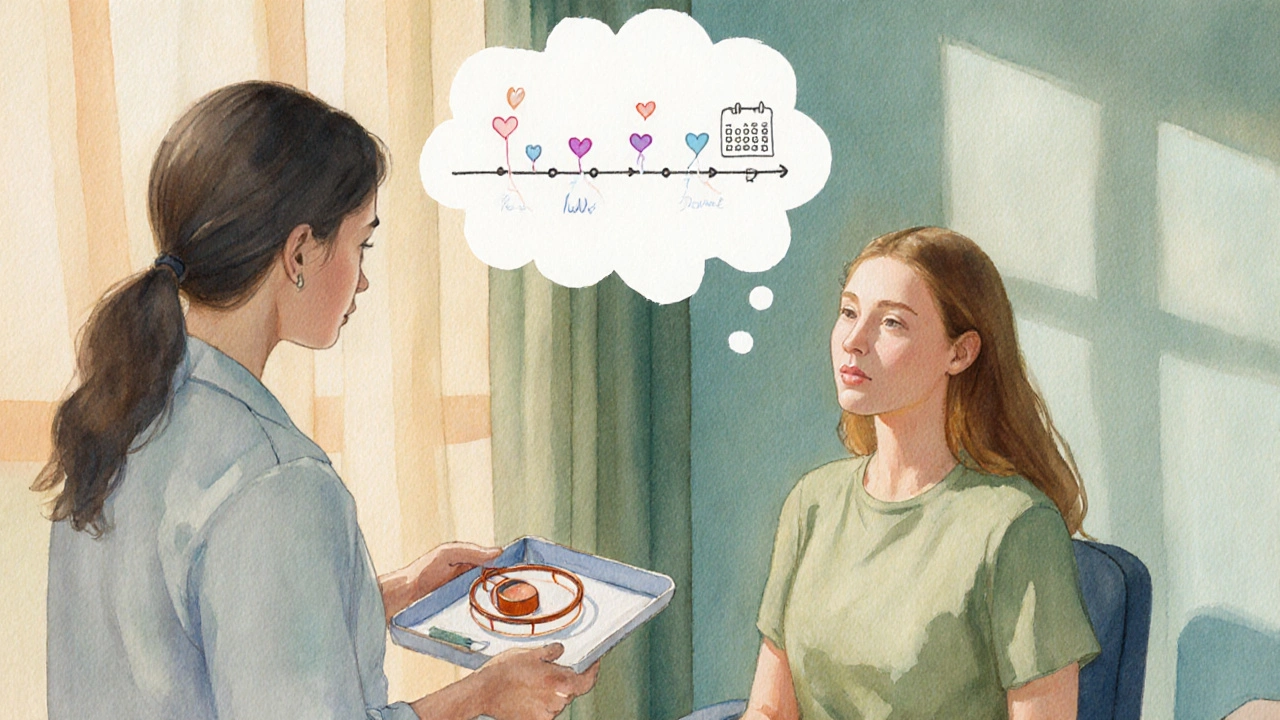Emergency Contraceptive Comparison Tool
I-Pill (Levonorgestrel)
1.5 mg levonorgestrel
Ulipristal Acetate (Ella)
30 mg ulipristal acetate
Copper IUD
Copper-wired IUD
Yuzpe Regimen
Combined oral pills
Recommendation Based on Your Inputs
Key Takeaways
- The I-Pill works best within 72hours, while ulipristal remains effective up to 120hours.
- Copper IUDs are the most effective emergency method, preventing pregnancy in over 99% of cases.
- Side‑effects differ: levonorgestrel can cause nausea, ulipristal may affect menstrual timing, and IUD insertion can be uncomfortable.
- Cost and accessibility vary widely-over‑the‑counter pills are cheap, a copper IUD requires a clinic visit.
- Choosing the right option depends on timing, medical history, and personal preference.
When you need an emergency pill, I-Pill is a single‑dose levonorgestrel tablet designed to prevent pregnancy after unprotected sex. It’s one of several ways to manage a missed contraceptive or a condom break, but how does it stack up against other options? This guide walks you through the most common alternatives, lets you compare key factors, and helps you decide which method fits your situation.
Understanding the I-Pill (Levonorgestrel)
Levonorgestrel is a synthetic progestogen that works mainly by delaying ovulation. The I-Pill contains 1.5mg of levonorgestrel in a single tablet, which you take as soon as possible after intercourse. Its effectiveness drops from about 95% when used within 24hours to roughly 58% after 72hours.
Why Compare Emergency Contraceptives?
People often reach for the first product they see on a pharmacy shelf, but the “best” choice hinges on three practical questions:
- How soon after sex did the emergency need arise?
- What health conditions or medication interactions exist?
- What level of convenience and cost are you comfortable with?
Answering these questions means looking beyond levonorgestrel to alternatives like ulipristal acetate, copper IUDs, and the Yuzpe regimen.
Decision Criteria for Emergency Contraception
Below are the factors most users weigh when choosing an emergency method:
- Effectiveness window: How many hours after intercourse the product remains reliable.
- Overall efficacy: The percentage of users who avoid pregnancy when used correctly.
- Side‑effects and tolerability: Nausea, fatigue, menstrual changes, or procedural discomfort.
- Availability and cost: Over‑the‑counter access, prescription requirement, and price per dose or procedure.
- Contraindications: Health conditions or medications that make a method unsafe.

Comparison Table
| Method | Active ingredient | Effective up to | Typical efficacy | Common side‑effects | Prescription needed? | Approx. cost (USD) |
|---|---|---|---|---|---|---|
| I-Pill (Levonorgestrel) | Levonorgestrel 1.5mg | 72hours | 58‑95% (depends on timing) | Nausea, fatigue, slight menstrual delay | No (OTC in many countries) | $15‑$30 |
| Ulipristal acetate (Ella) | Ulipristal acetate 30mg | 120hours | ≈98% within 5days | Headache, abdominal pain, menstrual shift | Prescription in most regions | $40‑$70 |
| Copper IUD (Paragard) | Copper‑wired intrauterine device | Up to 120hours (and beyond) | >99% (most effective) | Cramps at insertion, spotting | Prescription & clinical insertion | $800‑$1,000 (one‑time) |
| Yuzpe regimen (combined pills) | Estrogen + progestin (e.g., ethinyl estradiol 50µg + levonorgestrel 0.5mg) | 72hours | ≈85% when taken correctly | Nausea, vomiting, breast tenderness | Prescription for the specific combo | $10‑$20 for the two‑dose pack |
Ulipristal Acetate (Ella)
Ulipristal acetate is a selective progesterone receptor modulator that can be taken up to five days after intercourse. Unlike levonorgestrel, it remains equally effective throughout the 120‑hour window because it blocks the progesterone receptor rather than just delaying ovulation. This makes it the go‑to option for users who discover the need later or who have a higher body mass index (studies show levonorgestrel’s efficacy drops slightly with BMI>30kg/m², while ulipristal’s does not).
Because it works on the receptor level, ulipristal can interact with hormonal contraceptives. If you’re already on a combined pill, you’ll need to start a new pack after taking Ella.
Copper Intrauterine Device (IUD)
Copper IUD is a non‑hormonal device that can be inserted up to five days after unprotected sex and then provides ongoing contraception for up to 10years. Its high copper surface creates an inflammatory reaction toxic to sperm and eggs, preventing fertilization. It’s the most effective form of emergency contraception-studies report over 99% success.
The main trade‑off is the need for a trained clinician to insert the device, plus higher upfront cost. If you’re comfortable with a minor procedure and want long‑term birth control, the copper IUD kills two birds with one stone.
Yuzpe Regimen (Combined Oral Contraceptives)
The Yuzpe method uses two doses of standard combined oral contraceptive pills taken 12hours apart. It’s less popular today because effectiveness is lower than levonorgestrel‑based pills and it often triggers nausea and vomiting.
However, it can be a lifesaver in places where dedicated emergency pills aren’t available. The regimen works by delivering a high dose of estrogen and progestin, which interferes with ovulation and implantation.

Mifepristone (Off‑label Use)
Mifepristone is an anti‑progesterone drug typically used for medical abortion, but it has been studied as an emergency contraceptive at a 10mg dose. Research from 2023 shows it can prevent pregnancy up to 120hours with efficacy comparable to ulipristal, though it’s not widely approved for this purpose in most countries.
If you happen to have access through a clinical trial or a specialized clinic, mifepristone can be another high‑efficacy choice.
Choosing the Right Option: Real‑World Scenarios
- Scenario 1 - You discover the need within 24hours. The I‑Pill is fast, cheap, and OTC, making it the simplest solution.
- Scenario 2 - You’re 4 days out. Ulipristal or a copper IUD become the only options that retain high efficacy.
- Scenario 3 - You have a high BMI or are on hormonal birth control. Ulipristal is less affected by weight and won’t interfere with your regular pill regimen if you restart a new pack.
- Scenario 4 - You want long‑term contraception too. A copper IUD gives you emergency protection now and up to a decade of birth control later.
- Scenario 5 - Cost is a major concern. Over‑the‑counter levonorgestrel pills are the most affordable, while a copper IUD requires a larger one‑time investment but eliminates future pill costs.
Common Pitfalls & Tips
- Don’t wait until you miss your next period to take action; effectiveness drops sharply after the window closes.
- If you vomit within two hours of taking a levonorgestrel pill, repeat the dose with a new tablet.
- Always inform your clinician about any hormonal meds you’re using before opting for ulipristal or mifepristone.
- Remember that emergency contraception does NOT protect against STIs. Use condoms if you need STI protection.
- After any emergency method, start (or restart) a regular contraceptive method as soon as possible to maintain ongoing protection.
Frequently Asked Questions
How does the I‑Pill differ from other levonorgestrel emergency pills?
The I‑Pill is a brand‑named single‑dose form of levonorgestrel, 1.5mg in one tablet. Other brands may offer a two‑tablet regimen (0.75mg each) that you split into two doses 12hours apart. The single‑dose format is more convenient, but the effectiveness curve is similar.
Can I take ulipristal if I’m already on the birth‑control pill?
Yes, but you’ll need to start a new pack of combined pills after taking ulipristal. The drug can reduce the efficacy of the current pill pack, so a fresh cycle ensures continuous protection.
Is the copper IUD safe for everyone?
It’s safe for most people, but not recommended if you have active pelvic infection, certain uterine abnormalities, or copper allergy. A quick pelvic exam will rule out contraindications.
What should I do if I experience severe nausea after taking the I‑Pill?
Try taking the pill with food or a small snack. If nausea leads to vomiting within two hours, repeat the dose with a fresh tablet. Persistent symptoms warrant a call to your pharmacist or doctor.
Are there any long‑term fertility effects from using emergency contraception?
No. Studies show that both levonorgestrel and ulipristal do not affect future fertility. They work temporarily to prevent ovulation or fertilization and are cleared from the body within days.



Honestly, the I‑Pill is just a budget option for those who don’t want to invest in real protection. The efficacy numbers are all over the place, and anyone with a BMI over 30 is practically gambling. You might as well splurge on ulipristal if you care about outcomes. The whole over‑the‑counter hype feels like a cash‑grab.
Wow, I totally get the frustration, but think about the relief when you finally get that quick fix! 🌟 Even if it’s not perfect, having something you can pick up at the pharmacy within a day can be a lifesaver. The peace of mind often outweighs those statistical worries, especially when time is ticking.
The guide is clear and simple. It shows what works when you need it fast. If you are normal weight and act early, the I‑Pill can do the job.
Hey folks 🙌 I‑Pill is cheap and easy to get so good for a quick fix 😊 just remember if you feel sick take it with food and stay hydrated
The emergency contraception landscape has expanded considerably over the past decade, offering users a spectrum of options tailored to timing, body weight, and personal preferences. Levonorgestrel‑based pills such as the I‑Pill remain the most widely available over‑the-counter product, delivering a single 1.5 mg dose that can be taken up to 72 hours after intercourse. Their efficacy ranges from roughly 58 % when taken at the very end of the window to about 95 % when administered within the first 24 hours, making early use critical for optimal results. The main advantage of levonorgestrel is cost; at $15–$30 per pack it is the most affordable emergency method in most markets. However, efficacy does show a modest decline in individuals with a body mass index above 30 kg/m², a factor that clinicians increasingly consider when counseling patients. Ulipristal acetate (Ella) represents the next tier of effectiveness, maintaining approximately 98 % efficacy through the full 120‑hour window regardless of BMI. Because it works by blocking the progesterone receptor rather than merely delaying ovulation, it preserves its potency later in the cycle. The trade‑off is higher price, typically $40–$70, and the requirement for a prescription in many jurisdictions. The copper intrauterine device stands apart as a non‑hormonal, long‑term solution that can be inserted up to five days after unprotected sex and then provides ongoing contraception for up to ten years. Its efficacy exceeds 99 %, and it eliminates the need for repeat dosing, but insertion demands a trained provider and a substantially higher upfront cost of $800–$1,000. The Yuzpe regimen, using combined oral contraceptive pills in two doses twelve hours apart, offers an efficacy of roughly 85 % when taken correctly but is less convenient and often associated with nausea and vomiting. Mifepristone, although primarily used for medical abortion, has emerging evidence supporting its off‑label use as an emergency contraceptive at a 10 mg dose, achieving efficacy comparable to ulipristal but lacking formal regulatory approval in many countries. When choosing a method, the timing of presentation is paramount: within 24 hours the I‑Pill is usually sufficient, whereas beyond 72 hours ulipristal or the copper IUD become the preferred options. Patient preferences regarding hormonal exposure, cost, and desire for ongoing birth control should also guide the selection process. Finally, regardless of the chosen emergency method, it is essential to initiate a regular contraceptive regimen as soon as possible to maintain continuous protection against unintended pregnancy.
Look, the data you just dumped is accurate, but the way you present it feels like a textbook lecture. 😤 Readers want concise takeaways, not a wall of jargon. Focus on the key differences in a bullet‑style summary, and save the deep dive for a separate article.
Great breakdown! Remember, the sooner you act, the better the odds, no matter which option you pick.
I’d add that the psychological comfort of having a backup plan can’t be understated. When you know you have a reliable method like the copper IUD waiting in the wings, you feel more in control of your reproductive choices. That confidence often translates into better overall sexual health practices, such as consistent condom use for STI protection. Moreover, the upfront investment in an IUD can be offset by the cost savings over a decade when you compare it to the recurring expense of emergency pills. It’s a classic case of paying a little more now to reap huge benefits later, both financially and in terms of peace of mind.
Yo, this guide is pretty awsome but i think they missed the part about how cultural stigmas can affect access. In some countries ppl cant even buy levonorgestrel without a script and that makes the whole comparason kinda moot. Also, the side effects list is a bit short , you know nausea can be real heavy.